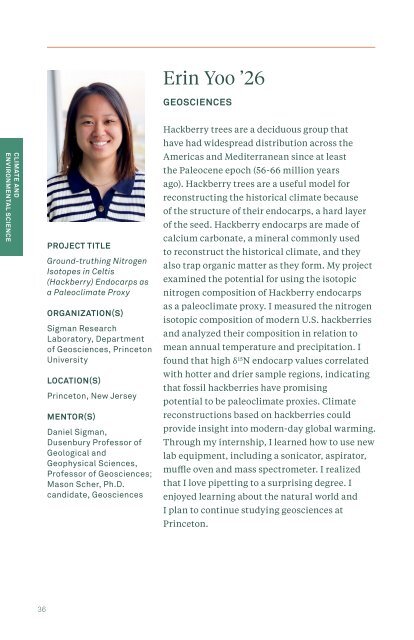Environmental Internship Program - 2023 Booklet
You also want an ePaper? Increase the reach of your titles
YUMPU automatically turns print PDFs into web optimized ePapers that Google loves.
Erin Yoo ’26<br />
GEOSCIENCES<br />
CLIMATE AND<br />
ENVIRONMENTAL SCIENCE<br />
PROJECT TITLE<br />
Ground-truthing Nitrogen<br />
Isotopes in Celtis<br />
(Hackberry) Endocarps as<br />
a Paleoclimate Proxy<br />
ORGANIZATION(S)<br />
Sigman Research<br />
Laboratory, Department<br />
of Geosciences, Princeton<br />
University<br />
LOCATION(S)<br />
Princeton, New Jersey<br />
MENTOR(S)<br />
Daniel Sigman,<br />
Dusenbury Professor of<br />
Geological and<br />
Geophysical Sciences,<br />
Professor of Geosciences;<br />
Mason Scher, Ph.D.<br />
candidate, Geosciences<br />
Hackberry trees are a deciduous group that<br />
have had widespread distribution across the<br />
Americas and Mediterranean since at least<br />
the Paleocene epoch (56-66 million years<br />
ago). Hackberry trees are a useful model for<br />
reconstructing the historical climate because<br />
of the structure of their endocarps, a hard layer<br />
of the seed. Hackberry endocarps are made of<br />
calcium carbonate, a mineral commonly used<br />
to reconstruct the historical climate, and they<br />
also trap organic matter as they form. My project<br />
examined the potential for using the isotopic<br />
nitrogen composition of Hackberry endocarps<br />
as a paleoclimate proxy. I measured the nitrogen<br />
isotopic composition of modern U.S. hackberries<br />
and analyzed their composition in relation to<br />
mean annual temperature and precipitation. I<br />
found that high δ 15 N endocarp values correlated<br />
with hotter and drier sample regions, indicating<br />
that fossil hackberries have promising<br />
potential to be paleoclimate proxies. Climate<br />
reconstructions based on hackberries could<br />
provide insight into modern-day global warming.<br />
Through my internship, I learned how to use new<br />
lab equipment, including a sonicator, aspirator,<br />
muffle oven and mass spectrometer. I realized<br />
that I love pipetting to a surprising degree. I<br />
enjoyed learning about the natural world and<br />
I plan to continue studying geosciences at<br />
Princeton.<br />
36
















